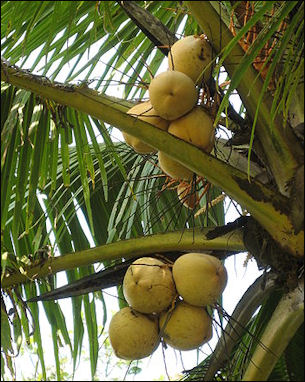COCONUTS
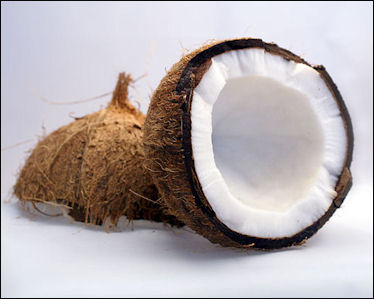
Coconuts are the seed (or nut or fruit) of the coconut palm, or “Cocos nucifera” . They have many uses: the meat is eaten raw, cooked or dried; the oil is made into soap or cooking oil; the sap from the tree is fermented into a strong alcoholic drink; the husk of the shell can be twisted into rope or twine; and various parts of the tree can be used for constructing houses. They also provide materials baskets, fuel, medicines, dye, yeast, fertilizer, corks, cups, bowls, musical instruments, decorations, jewelry and even clothing for millions of people in coastal areas and islands in tropical areas all over the world. The word coconut is derived from the Portuguese word “coco” , which means grimace because it resembles a grimacing face.[Source: Andrew Forbes, Donald Wilson and Rainier Krack, Crescent Press Agency]
According to one Indonesia saying, there are as many uses for the coconut as there are day in the year." According to a South Pacific proverb: "He who plants a coconut tree plants food and drink, vessels and clothing, a habitation for himself and a heritage for his children." Coconuts are an important food and cash crop in the Pacific and the Indian ocean regions.
Coconut palms are found naturally in tropical coastal areas all around the globe. Because they are so widely distributed as a result of coconuts floating on the world's oceans it is not clear where they originated from. Coconuts may grow where the fall or be carried away and give birth to new trees thousands of miles from where they originated from. Coconuts from the West Indies are sometimes found washed up in 3,000 miles away in England or are spotted in the middle of the sea by passengers in ocean liners
Coconut palms are one of the first plants to appear on tropical islands. Coconuts survive long voyages at sea because the fiber on the shells is thick, light and water tight, allowing the coconut to float, plus there a lot of food inside for the seed to feed on.
Websites and Resources: Coconut Research Center coconutresearchcenter.org ; Plant Cultures plantcultures.org/plants/coconut ; Wikipedia article Wikipedia ; How to Open a Coconut howtoopenacoconut.com ; Coconut Info coconut-info.com ;
World’s Top Coconut Producing Countries
Coconuts on a tree World’s Top Producers of Coconuts (2020): 1) Indonesia: 16824848 tonnes; 2) India: 14695000 tonnes; 3) Philippines: 14490923 tonnes; 4) Brazil: 2458839 tonnes; 5) Sri Lanka: 2233600 tonnes; 6) Vietnam: 1719415 tonnes; 7) Papua New Guinea: 1217293 tonnes; 8) Mexico: 895291 tonnes; 9) Thailand: 827424 tonnes; 10) Malaysia: 560984 tonnes; 11) Myanmar: 541415 tonnes; 12) Bangladesh: 431596 tonnes; 13) Dominican Republic: 429546 tonnes; 14) Ghana: 412459 tonnes; 15) China: 400417 tonnes; 16) Tanzania: 382162 tonnes; 17) Vanuatu: 270372 tonnes; 18) Mozambique: 251122 tonnes; 19) Nigeria: 225574 tonnes; 20) Samoa: 182672 tonnes ; [Source: FAOSTAT, Food and Agriculture Organization (U.N.), fao.org. A tonne (or metric ton) is a metric unit of mass equivalent to 1,000 kilograms (kgs) or 2,204.6 pounds (lbs). A ton is an imperial unit of mass equivalent to 1,016.047 kg or 2,240 lbs.]
World’s Top Producers (in terms of value) of Coconuts (2019): 1) Indonesia: Int.$2795526,000 ; 2) Philippines: Int.$2409777,000 ; 3) India: Int.$2396222,000 ; 4) Sri Lanka: Int.$402928,000 ; 5) Brazil: Int.$380430,000 ; 6) Vietnam: Int.$273707,000 ; 7) Mexico: Int.$210205,000 ; 8) Papua New Guinea: Int.$194677,000 ; 9) Thailand: Int.$131550,000 ; 100 Malaysia: Int.$87578,000 ; 11) Myanmar: Int.$86636,000 ; 12) Bangladesh: Int.$70440,000 ; 13) Tanzania: Int.$69950,000 ; 14) Dominican Republic: Int.$68802,000 ; 15) Ghana: Int.$65921,000 ; 16) China: Int.$65488,000 ; 17) Vanuatu: Int.$49376,000 ; 18) Mozambique: Int.$37990,000 ; 19) Nigeria: Int.$37469,000 ; [An international dollar (Int.$) buys a comparable amount of goods in the cited country that a U.S. dollar would buy in the United States.]
Top Coconut Producing Countries in 2008: (Production, $1000; Production, metric tons, FAO): 1) Indonesia, 1763580 , 19500000; 2) Philippines, 1367481 , 15319500; 3) India, 985253 , 10894000; 4) Brazil, 249527 , 2759044; 5) Sri Lanka, 199944 , 2210800; 6) Thailand, 134206 , 1483927; 7) Mexico, 112724 , 1246400; 8) Viet Nam, 98217 , 1086000; 9) Papua New Guinea, 61227 , 677000; 10) Malaysia, 41187 , 455408; 11) Myanmar, 33462 , 370000; 11) United Republic of Tanzania, 33462 , 370000; 13) Ghana, 28579 , 316000; 14) Vanuatu, 27828 , 307700; 15) China, 26943 , 297911; 16) Solomon Islands, 24961 , 276000; 17) Jamaica, 24020 , 265600; 18) Mozambique, 23966 , 265000; 19) Nigeria, 21162 , 234000; 20) Samoa, 14018 , 155000;
Palms
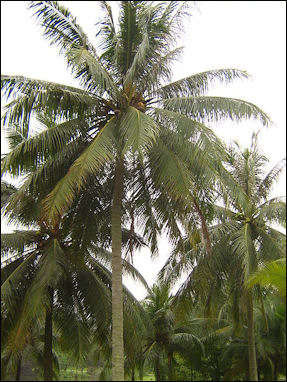
Coconut tree Next to grains and other grasses, palms are regarded as the most useful of all plants. They yield coconuts, palm oil, sugar, dates and materials that are used to make houses, boats, baskets, furniture and other things.
Palms grow primarily in tropical areas but are also found in the highlands of the Himalayas and the Andes, in mangrove swamps and in the desert. Members of a diverse plant group that also includes grasses and orchids, they range in height from six inches to 200 feet. Some palms are trees. Some are bushes. Rattan palms, which grow as a vine, can reach lengths of 600 feet or more.
Palm trees do not branch. They generate all their growth from a huge bud at the apex of the tree, which is called the palm heart. It produces leaf after leaf as the plant grows. The palm heart is often very tasty and animals like to eat it. If something happens to it the plant can die. Many palms have sharp spines for protection.
Palm trunk have a pith center but no bark or growth rings. Leaves called fonds fan out from a crown at the top. Some leaves are 30 to 45 feet long and 4 to 8 feet wide. African raffia palms have the world’s largest leaves, reaching 75 feet in length.
Palms bear flowers and fruit. The fruits have hard kernels containing tiny germs. Some kernels, such as dates, are surrounded by a fleshy pulp. The world’s largest seed, a double coconut from the Seychelles, comes from a palm. Most palms begin flowering when they five or six and mature when they are 10 to 15 years old. Some palms live 150 years or more.
Uses and Kinds of Palms
There are several thousand species of palms. Valuable kinds of palm include coconut palms, date palms, sago palms, betel nut palms. Some palms produces a sweet sap that is made into candy, sugar and wine. The nuts of the tagua palm yields vegetable ivory. Carnauba palm leaves produce wax.
Palm tree trunks are used in the construction of houses, boats and bridges that cross canals. They are used to make grids and fences. Elastic fibers that the cover the trunks are used to make camel and horse saddles. Parts of the leafstalk are used as trowels by mason and as beaters by washerwomen. Mats, plates and baskets are made with stalks. Among the other things made with palms are dye, paper, surfboards, and wax.
Coconut Palms
Coconut palms may reach a height a height of 100 feet but generally grow to a height of 30 or 50 feet and may. Coconuts hang in clusters of 15 to 20 from the top of the tree. They are green at first and turn brown when they mature. A tree can bear fruit for 70 to 80 years.
Coconut palms have a smooth unbranched trunk that is anchored in place with a swollen bases and proper roots. The trunk is topped by a crown of leaves that can reach a length of 20 feet and are be comprised of leaflets 18 to 30 inches long. The flowers are long, wavy spikes that hang down from the top of the tree. The root systems are fairly shallow, which is why coconut palm trees are often toppled in hurricanes and other storms.
Mature coconuts are oval in shape and about 12 to 18 inches long. They consist of a single-seeded nut surrounded by a hard shell and thick, fibrous husk. The entire coconut, except the husk, is the kernel. The pulp and liquid inside the kernel support the germ during its early growth. Coconut palms have traditionally relied on the sea to disperse their seeds (the coconuts). The cushiony fibers known as the core, help the nut survive the long fall from a tree as well stay afloat in the sea.
Coconuts as Food
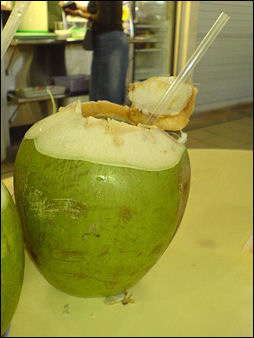
Coconut drink
In their shells, coconuts contain white meat and around a half pint of clear liquid. Coconut juice or water is the sweet clear liquids found in freshly opened coconuts. It is both low in calories and low in fat. Coconut milk is the creamy white liquid produces by squeezing the meat of a newly opened coconuts. Coconut oil is produced by squeezing the meat after it has dried. The soft material between the meat and milk is sometimes called coconut jelly.
In many places coconut water is drunk, coconut oil is used for cooking, palm sap from the tree is made into fermented drinks and coconut milk is used to a flavor foods. Coconut milk and coconut oils are featured in a number of cuisines, particularly those of South and Southeast Asia and the Pacific, where it is used to enrich soups, curries, stews, sauces, baked goods and other dishes. Where coconuts are produced, ripe, brown coconuts sell for $5 to $15 per hundred and green ones sell for 25 cents each. Coconuts are often sold green and immature. They have more water but the water is less sweet.
Coconut milk is made with grated coconut flesh mixed with water and pressed and strained. Coconut cream is the liquid from the first pressing. Thinner coconut milk is obtained from a second mixing and pressing. In some markets you can see coconut sellers grating the flesh in a machine. Some cooks make their own coconut milk at home. Coconut milk is sold in cans for cooking in stores and is used in some carbonated beverages. Unlike coconut oil, it is free of cholesterol but is relatively high in fat. Coconut milk is used all over
To make sure a coconut is ripe shake it to make sure it has water in it. Then cut of part of the husk with a machete to expose the top. To get the water puncture the shell at one of the indented spots at the top. Try to cut it open at the "eye." If water "spits" you know you missed the "eye" and hit the "mouth." To separate the meat from the shell tap it first with a hammer. Fresh coconut can be scooped with a spoon carved from the husk.
Coconut Oil and Copra
Copra is dried white coconut meat. It is produced by splitting the nut in half and letting it the meat dry in the sun and for 17 hours in a hot-air dryer. Coconut oil is squeezed from copra, which is about 50 percent oil.
Coconut oil is used for cooking and as an additive in foods such as margarine and candy. It is rich in fat that used to make soaps, detergents, shampoos, synthetic rubber, perfumes, face creams, tanning lotions, hair dressings, hair lacquer, even nitroglycerin. Refined oil, with the fatty acid removed, is used to make margarine and cosmetics. Coconut oil is used by local people in shampoos and soap to moisturize hair and skin. It is also used by some Islanders as adornment, medicine and a way of warding off evil spirits.
Copra is used in confectionaries. About 65 percent of oil produced is used in shampoos, margarine, soap, cooking oil and suntan lotion. Recently copra and coconut oil sales have plummeted because coconut oil is high in unhealthy fats (it is 80 percent saturated fats) and other oils can easily be substituted for it.
Indonesia and the Philippines are the world's largest producers of copra. Harvest from wild palms and trees grown on small plantations, coconut and copra are also important exports from many Pacific islands.
Other Coconut Parts
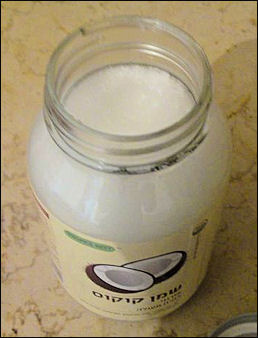
Hardened coconut oil Coconut palm fonds, or leaves, are plaited to make thatch roofing, brooms, food covers, wraps and plates and even tooth brushes. The wood is used for making fishing boats, housing and furniture. Treated and polished wood is exported abroad as "porcupine wood" and used for making cabinets. The sap from the wood is made into soothing eye balms.
Nothing in a coconut is wasted. Husks are often used in fires. Roots are ground into medicines and tooth powders. The thin center of young palm leaves can woven into hats. Fluid is fed to pigs. Left over meal and desiccated residue is fed to is feed to other animals. Charcoal from the shells is used in gas masks. Coconut fibre from the husk of green coconuts is twisted into twine and rope. Leaves are used in torches. Coconut shells are burned and made into buttons and household objects like bowls, spoons and containers and tacky tourist souvenirs as well high quality charcoal that is used commercially.
Coconut husks yield “coir” fiber which is made into twine, rope, insulation, mats, baskets, brushes, brooms, fishing nets, fencing, and even water resistant capes. Twisted coir fiber is sometimes used commercially as filling for car seats.
Clothes maker GoLite produces polyester shirts reinforced with odor-absorbing carbon from coconut shells. The shirts also provide sun protection and absorb moisture twice as fast as traditional polyester.
Coconut husks can be burned for fuel. The oil can burned to produce light. Coconut oil mixed with kerosene is used is as automobile fuel in Thailand . The idea was proposed by a coconut farmers as a solution for the problem of declining demand for coconut oil caused by health concerns. A village teacher and coconut farmer developed an engine that ran on coconut oil and used oil used by street vendors to fry donuts mixed with a small amount of kerosene to give it a “kick.” The engines have been used at shrimp farms and on ocean-going fishing boats used around Koh Samui.
Coconut Tree Climbers
Coconuts have traditionally been harvested by hand. Notches are carved in the trunks of the trees and men scramble up. It is dangerous work. A vendor who sells coconuts on the streets climb on average of 20 trees to collect enough coconuts to sell. Tree climbers not only harvest coconuts they trim the palm fonds and clean the tree’s bushy heads to prevent disease.
The coconut industry would be revolutionized if a machine that picks coconuts was invented. In Kerala, India a reward o $20,000 is being offered to anyone who can invent such a machine. Attempts at using dwarf species and harvesting with long sticks have not worked out. In some parts of India hydraulic platforms lift harvesters.
Coconut tree climbing has traditionally been done by boys and young men but these day more boys are choosing to go to school and young men are choosing safer, less arduous means of making a living, The problem is becoming so serious in some places that coconuts are going unharvested and trees are becoming diseased.
Coconut Monkeys
In some parts of Malaysia, pig-tailed macaques (a relatively russet, rain forest monkey native to Southeast Asia) have been trained to climb trees and pick coconuts for human masters. [Source: Randall Peffer, Smithsonian magazine]
Known locally as beroks, they can harvest 300 or 400 coconuts in a morning before they tire in the hot sun. They are connected to their human handlers by thin ropes or chains. The best monkeys can harvest 800 coconuts a day and clear a whole grove in a day by leaping 30 feet from tree to tree and tossing down coconuts like cluster bombs.
One handler told Smithsonian, "the big males are best for picking from tall trees, where the work is hard. But the males can be difficult to manage; they are strong and have large canines. Young beroks are easier to work with but are not always as productive."
Humans are sometimes faster than beroks on a single tree but monkeys have more endurance, they can sometimes leap from tree to tree, and they aren't bothered as much by stinging ants, scorpions and poisonous snakes that often inhabit the top of coconut palms.
Coconut Monkeys at Work
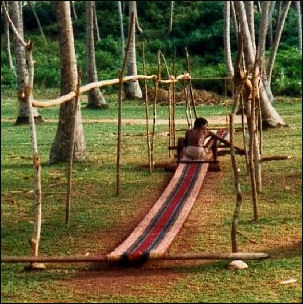
Making a coconut rug in Sri Lanka Monkeys are sometimes employed in the coconut industry to climb up trees and bring down coconuts. The monkeys and their handlers are contracted out by planation owners. They are taught not to bring down any old coconut but only the young ones with tender meat. They are fickle though and won't work when they are tired.
Monkeys that respond to voice commands are sometimes used to pick coconuts. Sometimes a owner will get monkeys to work in pairs or teams to bring down hard to reach nuts.
Describing a berok named Hitam at work on 80-foot-high trees, Randall Peffer, wrote in Smithsonian magazine, "Led to the first tree, the berok rapidly shins up. Tahar [the handler] lets out coils of leash until the monkey is swaying among the fronds. Almost immediately the tree begins to shake as Hitam struggles to break a coconut from its tough stem. Rustling noises disturb the silence and Tahar moves quickly to dodge the coconuts that suddenly begin to thump on the soft ground around him."
"After five or six coconuts are plucked. Tahar tugs on the leash for Hitam to climb down and try the next tree some 25 to 30 feet away. The work is slow; Hitam lacks the speed and strength of larger, more experienced berok."
The Malay writer Fatima Busu, once explained, "Beroks are so like us. They can be loving and cooperative but also mean spirited, selfish and lustful. Also very independent. We can love this animal. We can hate it, all at the same time."
Coconut Monkeys, Their Handlers and Training
At home the beroks are kept tethered to poles and are transported from place to pace on platforms on the back of bicycles. Or motorbikes. If a berok falls and breaks a leg it is given a splint, hand feed, bathed by its handler until it recovers. Monkey have been known to protect their handlers from wild dogs and raise a call of alarm when a poisonous snake is near.
One handler told Smithsonian, "I give my monkeys affection every day. I sit with them, and we groom one another. We share fruit or walk to the river together to bathe." Sometimes the monkeys are offspring of berok; sometimes they are caught on the forest with nets or traps. Often though, nursing mothers are shot are their babies ate taken.
Training the beroks involves patience, persistence, punishment and rewards, mimicry and persuading the monkey that picking coconuts is somehow to his or her advantage. A bond between the trainer and monkey and an understanding of macaque body language and social interaction are necessary.
Describing the training of berok by a trainer name Hajee, Peffer wrote: "First the man clips the monkey's wire collar to a leash, holds him close and dangles before him a ripe coconut on a stem and shows the berok how twisting the coconut will make it fall. Next the trainer places the monkey's hand on the coconut, and the monkey imitates what he has just seen. The coconut drops. At the end of the training session, Jajee cuts open the fruit and shares it with the trainee."
“On day two the coconut is tied to a low tree. The exercises of the day before are repeated, but this time the monkey has to climb a tree. Successful plucking is rewarded with another coconut feast. On the third day the monkey repeats this lesson and then follows his trainer to a tall palm."
Later the monkeys are taught to respond to commands, and pick ripe coconuts using a similar reward system. After a training period of around 20 days, the berok is ready to pick coconuts for five or six hours a day.
Coconut Cultivation
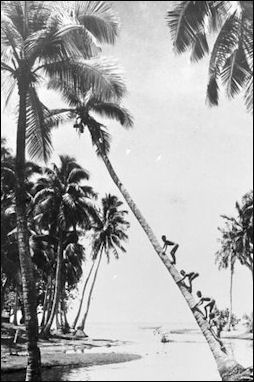
Coconut thrive in sandy coastal plains. They grow easily from the seed and require little attention. for the first two years. They begin to bear fruit after about six or seven years. Superior coconuts are used for replanting.
Most of the world's coconuts are grown on small native plantations. Sixth-month-old seedling, grown in nursery beds from unhusked nuts, are transplanted to sandy fields and spaced about ten metes apart. The nuts take a year to ripen. Little maintenance is required, A mature tree produced between 40 and 100 coconuts annually. The nuts sell for around six cents a piece.
After the coconuts are harvested the outer husks are hacked open with a machetes or ripped open with stationary metal spikes. The inner shell is split open to remove the meat. A person can shuck 1,000 coconuts a day. The meat is usually dried in the sun, and sometimes on racks over a fire. Mechanical drying is also done. On islands, supply ships make regular visits pick up the copa.
At copra processing plants mountains of dirty brown coconut meat are squeezed dry of their transparent coconut oil. The copra is usually pressed cold first. This yield the best quality oil. Grinding and pressing with hot water is used to get out about 65 percent if the oil. The remaining cake is used for fertilizer and livestock and poultry feed.
The oil is exported in barrels or drums or sometimes poured directly into tankers. Sometimes they are even transported in petroleum tanks whose tanks have been steam cleaned to remove any traces of the petroleum.
16 billion coconuts are harvested each year in India alone.
Copra Plantations in the Pacific
According to the “Encyclopedia of World Cultures”: “The demand for labor on Pacific islands was nearly limitless as European-owned plantations began to occupy vast tracts of land. While sugarcane was the major plantation crop in Queensland, Australia, and Fiji, the copra trade had a broader and longer-lasting influence. The dried meat of the coconut (copra) was highly valued as a source of oil for cooking, soaps, cosmetics, and other products in worldwide demand, and millions of coconut palms were planted and managed throughout the Pacific. [Source:“Encyclopedia of World Cultures, Volume 2: Oceania,” edited by Terence E. Hays, 1991 |~|]
Missionaries saw copra as a limitless source of cash, and commercial firms obtained rights to countless hectares of coastal and island land. For example, from 1884 to 1899, the Neu Guinea Kompagnie turned most of the coastline of northeastern New Guinea into plantations for copra, as well as tobacco and other crops, and, beginning in 1905, the firm of Lever Brothers established Lever's Pacific Plantations, Ltd., in much of Fiji and the Solomon Islands. Copra continues to be the major commercial export of many islanders.
Coconut Injuries
People periodically suffer concussions from getting smashed on the head with a falling coconut. Occasionally someone dies. In some South Pacific islands coconuts are serious health hazards. According to a study in the Australia New Zealand Journal of Surgery, coconut-related injuries are just as common as car and sports-related injuries in the Solomon Islands.
A four-kilogram coconut can fall 25 meters and reach a speed of 50 miles per hour at the point of impact. Most of the injuries however result from people harvesting coconuts falling out of trees. The injuries are particularly common among children.
Of the 105 coconut-related injuries reported over a five year period at the Central Referral Hospital in the Solomon Islands capital of Honiara, 85 were caused by falling out of trees, and 16 from falling coconuts. One young boy suffered severe brain damage after being struck on the head. Other children had fractured skulls. Some of the who fell had serious spinal injuries. A large number of coconut-related injuries have also been reported from Papua New Guinea.
In the mid 2000s there were reports that Rolling Stones guitarist Keith Richards was seriously injured by a falling coconut or from falling from a coconut tree in Fiji.
World’s Top Coconut Exporting Countries
.jpg)
World’s Top Exporters of Coconuts (2020): 1) Indonesia: 890196 tonnes; 2) Thailand: 261775 tonnes; 3) Vietnam: 124121 tonnes; 4) India: 52957 tonnes; 5) Cote d’Ivoire: 29372 tonnes; 6) Sri Lanka: 23471 tonnes; 7) Netherlands: 15855 tonnes; 8) Guyana: 10133 tonnes; 9) Mexico: 10112 tonnes; 10) Singapore: 10007 tonnes; 11) Hong Kong: 7421 tonnes; 12) United Arab Emirates: 7328 tonnes; 13) Malaysia: 7286 tonnes; 14) Belgium: 3446 tonnes; 15) Spain: 3418 tonnes; 16) United States: 2237 tonnes; 17) Venezuela: 2146 tonnes; 18) France: 1705 tonnes; 19) Philippines: 1571 tonnes; 20) Ghana: 1110 tonnes ; [Source: FAOSTAT, Food and Agriculture Organization (U.N.), fao.org]
World’s Top Exporters (in value terms) of Coconuts (2020): 1) Indonesia: US$219017,000; 2) Thailand: US$186519,000; 3) Vietnam: US$119878,000; 4) India: US$55195,000; 5) Netherlands: US$18095,000; 6) Côte d'Ivoire: US$14043,000; 7) Spain: US$10873,000; 8) Sri Lanka: US$10406,000; 9) Hong Kong: US$7213,000; 10) Guyana: US$6223,000; 11) Mexico: US$5478,000; 12) Belgium: US$5196,000; 13) United Arab Emirates: US$4638,000; 14) Singapore: US$3878,000; 15) Malaysia: US$3846,000; 16) United States: US$3524,000; 17) United Kingdom: US$3270,000; 18) Philippines: US$1840,000; 19) Ghana: US$1600,000; 20) France: US$1600,000
World’s Top Exporters of Desiccated Coconuts (2020): 1) Philippines: 145200 tonnes; 2) Indonesia: 128086 tonnes; 3) Singapore: 33611 tonnes; 4) Sri Lanka: 31500 tonnes; 5) Vietnam: 20021 tonnes; 6) Netherlands: 17478 tonnes; 7) Malaysia: 14625 tonnes; 8) Côte d'Ivoire: 11987 tonnes; 9) Dominican Republic: 11878 tonnes; 10) Germany: 8787 tonnes; 11) Mexico: 5328 tonnes; 12) United Arab Emirates: 4396 tonnes; 13) Ghana: 3698 tonnes; 14) Costa Rica: 2969 tonnes; 15) Turkey: 2640 tonnes; 16) United States: 2209 tonnes; 17) Canada: 1963 tonnes; 18) India: 1577 tonnes; 19) United Kingdom: 1433 tonnes; 20) France: 1429 tonnes
World’s Top Exporters (in value terms) of Desiccated Coconuts (2020): 1) Philippines: US$255094,000; 2) Indonesia: US$178797,000; 3) Sri Lanka: US$81421,000; 4) Netherlands: US$42648,000; 5) Vietnam: US$37682,000; 6) Singapore: US$31992,000; 7) Germany: US$20772,000; 8) Malaysia: US$13515,000; 9) Dominican Republic: US$7773,000; 10) United Arab Emirates: US$6889,000; 11) United States: US$5883,000; 12) Ghana: US$5181,000; 13) Canada: US$4621,000; 14) Turkey: US$4341,000; 15) United Kingdom: US$4181,000; 16) Mexico: US$3942,000; 17) France: US$3466,000; 18) India: US$3194,000; 19) Austria: US$2941,000; 20) Côte d'Ivoire: US$2102,000
World’s Top Coconut Importing Countries
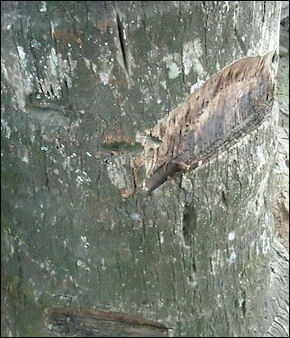
Notches in a tree that
make it easier to climb World’s Top Importers of Coconuts (2020): 1) China: 635822 tonnes; 2) Thailand: 357138 tonnes; 3) Malaysia: 288195 tonnes; 4) United Arab Emirates: 44053 tonnes; 5) United States: 43623 tonnes; 6) Singapore: 31909 tonnes; 7) Netherlands: 15974 tonnes; 8) Vietnam: 15661 tonnes; 9) Hong Kong: 11694 tonnes; 10) Spain: 8939 tonnes; 11) United Kingdom: 8452 tonnes; 12) Canada: 7775 tonnes; 13) Germany: 6729 tonnes; 14) Saudi Arabia: 6572 tonnes; 15) Pakistan: 6298 tonnes; 16) Palestine: 5700 tonnes; 17) Italy: 5539 tonnes; 18) Australia: 5263 tonnes; 19) Belgium: 4948 tonnes; 20) France: 4618 tonnes ; [Source: FAOSTAT, Food and Agriculture Organization (U.N.), fao.org]
World’s Top Importers (in value terms) of Coconuts (2020): 1) China: US$296493,000; 2) Thailand: US$130565,000; 3) Malaysia: US$63729,000; 4) United States: US$42356,000; 5) Vietnam: US$29579,000; 6) United Arab Emirates: US$17482,000; 7) Singapore: US$16958,000; 8) Netherlands: US$13492,000; 9) Germany: US$13026,000; 10) Hong Kong: US$12414,000; 11) United Kingdom: US$10528,000; 12) Canada: US$9663,000; 13) Palestine: US$9000,000; 14) Spain: US$6882,000; 15) Uruguay: US$6876,000; 16) Australia: US$6035,000; 17) Belgium: US$5841,000; 18) Italy: US$5159,000; 19) France: US$4898,000; 20) Saudi Arabia: US$4683,000
World’s Top Importers of Desiccated Coconuts (2020): 1) United States: 41151 tonnes; 2) Netherlands: 31884 tonnes; 3) Singapore: 27257 tonnes; 4) Benin: 26890 tonnes; 5) Germany: 20193 tonnes; 6) Russia: 17100 tonnes; 7) Turkey: 16779 tonnes; 8) China: 15685 tonnes; 9) United Kingdom: 15568 tonnes; 10) Dominican Republic: 15558 tonnes; 11) Thailand: 15147 tonnes; 12) Brazil: 13822 tonnes; 13) Malaysia: 11372 tonnes; 14) Canada: 11282 tonnes; 15) Poland: 9237 tonnes; 16) Australia: 8492 tonnes; 17) France: 7673 tonnes; 18) United Arab Emirates: 7431 tonnes; 19) Iraq: 6283 tonnes; 20) Egypt: 6044 tonnes
World’s Top Importers (in value terms) of Desiccated Coconuts (2020): 1) United States: US$89494,000; 2) Netherlands: US$54501,000; 3) Germany: US$40652,000; 4) Russia: US$32953,000; 5) United Kingdom: US$32448,000; 6) Thailand: US$29648,000; 7) Singapore: US$25529,000; 8) China: US$24909,000; 9) Canada: US$24870,000; 10) Egypt: US$23010,000; 11) Turkey: US$22305,000; 12) Poland: US$22222,000; 13) France: US$18527,000; 14) Brazil: US$18467,000; 15) Australia: US$16829,000; 16) Belgium: US$13361,000; 17) Malaysia: US$13026,000; 18) Iraq: US$12484,000; 19) Dominican Republic: US$11528,000; 20) United Arab Emirates: US$11427,000; [Source: FAOSTAT, Food and Agriculture Organization (U.N.), fao.org]
World’s Top Coconut Oil Producing and Exporting Countries
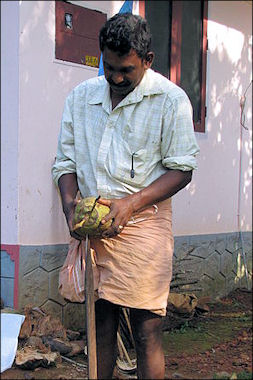
Coconut huskingWorld’s Top Producers of Coconut Oil (2019): 1) Philippines: 1193800 tonnes; 2) Indonesia: 895000 tonnes; 3) India: 351600 tonnes; 4) Vietnam: 179014 tonnes; 5) Mexico: 130400 tonnes; 6) Sri Lanka: 64500 tonnes; 7) Malaysia: 47300 tonnes; 8) Mozambique: 30900 tonnes; 9) Thailand: 29900 tonnes; 10) Bangladesh: 23200 tonnes; 11) Papua New Guinea: 22900 tonnes; 12) Cote d’Ivoire: 18000 tonnes; 13) Tanzania: 13200 tonnes; 14) Venezuela: 12650 tonnes; 15) Solomon Islands: 11600 tonnes; 16) Nigeria: 10801 tonnes; 17) Vanuatu: 10381 tonnes; 18) Jamaica: 9600 tonnes; 19) Brazil: 9479 tonnes; 20) Cambodia: 8554 tonnes ; [Source: FAOSTAT, Food and Agriculture Organization (U.N.), fao.org]
World’s Top Exporters of Coconut Oil (2020): 1) Philippines: 646432 tonnes; 2) Indonesia: 578048 tonnes; 3) Netherlands: 226433 tonnes; 4) Malaysia: 203362 tonnes; 5) Papua New Guinea: 31524 tonnes; 6) Sri Lanka: 21335 tonnes; 7) United States: 18907 tonnes; 8) Germany: 15637 tonnes; 9) Italy: 12273 tonnes; 10) Spain: 11316 tonnes; 11) India: 11096 tonnes; 12) Vietnam: 10934 tonnes; 13) Sweden: 9717 tonnes; 14) France: 7283 tonnes; 15) French Polynesia: 6804 tonnes; 16) Côte d'Ivoire: 6428 tonnes; 17) Canada: 6172 tonnes; 18) Solomon Islands: 5410 tonnes; 19) Belgium: 3022 tonnes; 20) Fiji: 2732 tonnes
World’s Top Exporters (in value terms) of Coconut Oil (2020): 1) Philippines: US$774199,000; 2) Indonesia: US$545739,000; 3) Netherlands: US$280855,000; 4) Malaysia: US$210410,000; 5) Sri Lanka: US$84787,000; 6) United States: US$50807,000; 7) Germany: US$42610,000; 8) Canada: US$35410,000; 9) Vietnam: US$30989,000; 10) India: US$30403,000; 11) Papua New Guinea: US$24521,000; 12) Italy: US$15989,000; 13) Sweden: US$15269,000; 14) Spain: US$13847,000; 15) France: US$10277,000; 16) Thailand: US$9733,000; 17) Slovenia: US$7281,000; 18) Solomon Islands: US$6934,000; 19) United Kingdom: US$6804,000; 20) Belgium: US$5815,000
World’s Top Coconut Oil Importing Countries
World’s Top Importers of Coconut Oil (2020): 1) United States: 454401 tonnes; 2) Netherlands: 334109 tonnes; 3) Malaysia: 239558 tonnes; 4) China: 162182 tonnes; 5) Germany: 157880 tonnes; 6) Italy: 85249 tonnes; 7) Sri Lanka: 76664 tonnes; 8) France: 60612 tonnes; 9) South Korea: 48227 tonnes; 10) Belgium: 42431 tonnes; 11) Spain: 41674 tonnes; 12) Indonesia: 41392 tonnes; 13) Japan: 37025 tonnes; 14) Russia: 29079 tonnes; 15) Poland: 27523 tonnes; 16) Canada: 25676 tonnes; 17) United Kingdom: 25220 tonnes; 18) Sweden: 24859 tonnes; 19) Singapore: 24064 tonnes; 20) Turkey: 20096 tonnes ; [Source: FAOSTAT, Food and Agriculture Organization (U.N.), fao.org]
World’s Top Importers (in value terms) of Coconut Oil (2020): 1) United States: US$565072,000; 2) Netherlands: US$294821,000; 3) Malaysia: US$217000,000; 4) Germany: US$177687,000; 5) China: US$158305,000; 6) Sri Lanka: US$88148,000; 7) Italy: US$82419,000; 8) France: US$71532,000; 9) Canada: US$63150,000; 10) Belgium: US$52032,000; 11) South Korea: US$51413,000; 12) Japan: US$43130,000; 13) Indonesia: US$41589,000; 14) Spain: US$40777,000; 15) United Kingdom: US$40771,000; 16) Poland: US$33867,000; 17) Russia: US$33726,000; 18) Singapore: US$29579,000; 19) Sweden: US$26725,000; 20) Turkey: US$20995,000
World’s Top Copra Exporting Countries
Copra refers to the dried coconut kernels from which coconut oil is obtained.
World’s Top Exporters of Copra (2020): 1) Indonesia: 107486 tonnes; 2) Papua New Guinea: 44731 tonnes; 3) Thailand: 43018 tonnes; 4) Vanuatu: 10555 tonnes; 5) Solomon Islands: 5592 tonnes; 6) India: 2288 tonnes; 7) Sri Lanka: 1102 tonnes; 8) Vietnam: 1091 tonnes; 9) Egypt: 954 tonnes; 10) Kiribati: 891 tonnes; 11) Timor-Leste: 666 tonnes; 12) Uganda: 527 tonnes; 13) Singapore: 192 tonnes; 14) United Arab Emirates: 53 tonnes; 15) Denmark: 44 tonnes; 16) Côte d'Ivoire: 37 tonnes; 17) Afghanistan: 29 tonnes; 18) Hong Kong: 21 tonnes; 19) Iran: 21 tonnes; 20) United Kingdom: 19 tonnes ; [Source: FAOSTAT, Food and Agriculture Organization (U.N.), fao.org]

Coconut farm World’s Top Exporters (in value terms) of Copra (2020): 1) Indonesia: US$36545,000; 2) Thailand: US$21394,000; 3) Papua New Guinea: US$19584,000; 4) India: US$4457,000; 5) Vanuatu: US$4373,000; 6) Solomon Islands: US$2286,000; 7) Sri Lanka: US$1634,000; 8) Egypt: US$1140,000; 9) Vietnam: US$952,000; 10) Kiribati: US$279,000; 11) Uganda: US$274,000; 12) Timor-Leste: US$171,000; 13) United Kingdom: US$113,000; 14) Singapore: US$101,000; 15) United Arab Emirates: US$87,000; 16) Denmark: US$87,000; 17) Hong Kong: US$51,000; 18) Afghanistan: US$27,000; 19) Iran: US$24,000; 20) France: US$12,000
World’s Top Exporters of Copra Cake (2020): 1) Philippines: 200846 tonnes; 2) Indonesia: 182836 tonnes; 3) Sri Lanka: 16600 tonnes; 4) Papua New Guinea: 11095 tonnes; 5) Cote d’Ivoire: 8027 tonnes; 6) Malaysia: 6047 tonnes; 7) Mozambique: 2460 tonnes; 8) Honduras: 1540 tonnes; 9) Vietnam: 1303 tonnes; 10) Germany: 831 tonnes; 11) Vanuatu: 830 tonnes; 12) Singapore: 353 tonnes; 13) Kiribati: 285 tonnes; 14) Fiji: 215 tonnes; 15) Japan: 156 tonnes; 16) United States: 132 tonnes; 17) Guyana: 126 tonnes; 18) India: 125 tonnes; 19) Thailand: 113 tonnes; 20) Lithuania: 92 tonnes
World’s Top Exporters (in value terms) of Copra Cake (2020): 1) Philippines: US$42130,000; 2) Indonesia: US$32404,000; 3) Sri Lanka: US$8055,000; 4) Malaysia: US$4108,000; 5) Papua New Guinea: US$2962,000; 6) Vietnam: US$1507,000; 7) Japan: US$787,000; 8) Thailand: US$782,000; 9) Singapore: US$727,000; 10) Germany: US$437,000; 11) Mozambique: US$352,000; 12) Vanuatu: US$239,000; 13) Canada: US$123,000; 14) Cote d’Ivoire: US$109,000; 15) Kiribati: US$97,000; 16) India: US$89,000; 17) Guyana: US$82,000; 18) Uruguay: US$68,000; 19) Italy: US$61,000; 20) Honduras: US$53,000
World’s Top Copra Importing Countries
World’s Top Importers of Copra (2020): 1) Bangladesh: 87342 tonnes; 2) Philippines: 58936 tonnes; 3) Pakistan: 14613 tonnes; 4) India: 13018 tonnes; 5) Nepal: 1997 tonnes; 6) Australia: 929 tonnes; 7) Indonesia: 926 tonnes; 8) Fiji: 891 tonnes; 9) Malaysia: 808 tonnes; 10) United Kingdom: 470 tonnes; 11) Taiwan: 348 tonnes; 12) South Korea: 320 tonnes; 13) Hungary: 242 tonnes; 14) Iran: 234 tonnes; 15) Singapore: 163 tonnes; 16) France: 144 tonnes; 17) Kuwait: 135 tonnes; 18) Myanmar: 119 tonnes; 19) Thailand: 112 tonnes; 20) Angola: 101 tonnes ; [Source: FAOSTAT, Food and Agriculture Organization (U.N.), fao.org]
World’s Top Importers (in value terms) of Copra (2020): 1) Philippines: US$28613,000; 2) Bangladesh: US$20814,000; 3) Pakistan: US$15165,000; 4) India: US$11678,000; 5) Nepal: US$4142,000; 6) Malaysia: US$379,000; 7) Iran: US$358,000; 8) Indonesia: US$348,000; 9) United Kingdom: US$346,000; 10) South Korea: US$335,000; 11) Kuwait: US$311,000; 12) Fiji: US$279,000; 13) Australia: US$273,000; 14) Taiwan: US$247,000; 15) United Arab Emirates: US$183,000; 16) Singapore: US$105,000; 17) Hong Kong: US$101,000; 18) Angola: US$99,000; 19) Myanmar: US$99,000; 20) Faroe Islands: US$98,000
World’s Top Coir Producing Countries, Exporting and Importing Countries

World’s Top Producers of Coir (2020): 1) India: 586686 tonnes; 2) Vietnam: 390541 tonnes; 3) Sri Lanka: 161791 tonnes; 4) Thailand: 64098 tonnes; 5) Ghana: 39548 tonnes; 6) Malaysia: 21454 tonnes; 7) Bangladesh: 10310 tonnes; 8) Cote d’Ivoire: 2196 tonnes ; [Source: FAOSTAT, Food and Agriculture Organization (U.N.), fao.org]
World’s Top Exporters of Coir (2020): 1) India: 1029430 tonnes; 2) Thailand: 58671 tonnes; 3) Vietnam: 1113 tonnes; 4) Sri Lanka: 1070 tonnes; 5) Belgium: 118 tonnes; 6) Germany: 35 tonnes; 7) Spain: 34 tonnes; 8) Austria: 19 tonnes; 9) Cambodia: 16 tonnes; 10) Cote d’Ivoire: 15 tonnes; 11) Portugal: 15 tonnes; 12) United States: 12 tonnes; 13) Nepal: 8 tonnes; 14) South Africa: 7 tonnes; 15) China: 5 tonnes; 16) Australia: 5 tonnes; 17) Netherlands: 4 tonnes; 18) Canada: 2 tonnes; 19) United Arab Emirates: 2 tonnes; 20) Slovakia: 2 tonnes ; [Source: FAOSTAT, Food and Agriculture Organization (U.N.), fao.org]
World’s Top Exporters (in value terms) of Coir (2020): 1) India: US$324539,000; 2) Thailand: US$13930,000; 3) Sri Lanka: US$887,000; 4) Vietnam: US$540,000; 5) Belgium: US$273,000; 6) Austria: US$171,000; 7) Germany: US$137,000; 8) Spain: US$71,000; 9) United States: US$48,000; 10) Nepal: US$31,000; 11) China: US$29,000; 12) Portugal: US$21,000; 13) Netherlands: US$20,000; 14) South Africa: US$14,000; 15) Slovakia: US$10,000; 16) Cambodia: US$9,000; 17) France: US$8,000; 18) Canada: US$5,000; 19) Brazil: US$4,000; 20) United Arab Emirates: US$4,000; 21) Italy: US$4,000; 22) Australia: US$4,000; 23) Poland: US$4,000; [Source: FAOSTAT, Food and Agriculture Organization (U.N.), fao.org]
World’s Top Importers of Coir (2020): 1) Iran: 5862 tonnes; 2) Russia: 4852 tonnes; 3) Nepal: 2229 tonnes; 4) United Arab Emirates: 1265 tonnes; 5) Maldives: 859 tonnes; 6) Netherlands: 853 tonnes; 7) Ethiopia: 849 tonnes; 8) Italy: 772 tonnes; 9) Japan: 675 tonnes; 10) Pakistan: 511 tonnes; 11) Tunisia: 480 tonnes; 12) United Kingdom: 385 tonnes; 13) Austria: 382 tonnes; 14) Uganda: 341 tonnes; 15) Tanzania: 335 tonnes; 16) Germany: 320 tonnes; 17) Oman: 287 tonnes; 18) Bahrain: 265 tonnes; 19) Trinidad and Tobago: 253 tonnes; 20) India: 240 tonnes ; [Source: FAOSTAT, Food and Agriculture Organization (U.N.), fao.org]
Image Sources: Wikimedia Commons
Text Sources: National Geographic, New York Times, Washington Post, Los Angeles Times, Smithsonian magazine, Natural History magazine, Discover magazine, Times of London, The New Yorker, Time, Newsweek, Reuters, AP, AFP, Lonely Planet Guides, Compton’s Encyclopedia and various books and other publications.
Last updated March 2022

